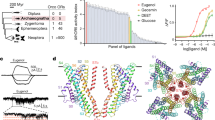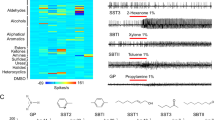Abstract
Blood-feeding insects such as mosquitoes are efficient vectors of human infectious diseases because they are strongly attracted by body heat, carbon dioxide and odours produced by their vertebrate hosts. Insect repellents containing DEET (N,N-diethyl-meta-toluamide) are highly effective, but the mechanism by which this chemical wards off biting insects remains controversial despite decades of investigation1,2,3,4,5,6,7,8,9,10,11. DEET seems to act both at close range as a contact chemorepellent, by affecting insect gustatory receptors12, and at long range, by affecting the olfactory system1,2,3,4,5,6,7,8,9,10,11. Two opposing mechanisms for the observed behavioural effects of DEET in the gas phase have been proposed: that DEET interferes with the olfactory system to block host odour recognition1,2,3,4,5,6,7 and that DEET actively repels insects by activating olfactory neurons that elicit avoidance behaviour8,9,10,11. Here we show that DEET functions as a modulator of the odour-gated ion channel formed by the insect odorant receptor complex13,14. The functional insect odorant receptor complex consists of a common co-receptor, ORCO (ref. 15) (formerly called OR83B; ref. 16), and one or more variable odorant receptor subunits that confer odour selectivity17. DEET acts on this complex to potentiate or inhibit odour-evoked activity or to inhibit odour-evoked suppression of spontaneous activity. This modulation depends on the specific odorant receptor and the concentration and identity of the odour ligand. We identify a single amino-acid polymorphism in the second transmembrane domain of receptor OR59B in a Drosophila melanogaster strain from Brazil that renders OR59B insensitive to inhibition by the odour ligand and modulation by DEET. Our data indicate that natural variation can modify the sensitivity of an odour-specific insect odorant receptor to odour ligands and DEET. Furthermore, they support the hypothesis that DEET acts as a molecular ‘confusant’ that scrambles the insect odour code, and provide a compelling explanation for the broad-spectrum efficacy of DEET against multiple insect species.
This is a preview of subscription content, access via your institution
Access options
Subscribe to this journal
Receive 51 print issues and online access
$199.00 per year
only $3.90 per issue
Buy this article
- Purchase on Springer Link
- Instant access to full article PDF
Prices may be subject to local taxes which are calculated during checkout




Similar content being viewed by others
References
Davis, E. E. & Sokolove, P. G. Lactic acid-sensitive receptors on the antennae of the mosquito, Aedes aegypti. J. Comp. Physiol. A 105, 43–54 (1976)
McIver, S. B. A model for the mechanism of action of the repellent DEET on Aedes Aegypti (Diptera: Culicidae). J. Med. Entomol. 18, 357–361 (1981)
Dogan, E. B., Ayres, J. W. & Rossignol, P. A. Behavioural mode of action of DEET: inhibition of lactic acid attraction. Med. Vet. Entomol. 13, 97–100 (1999)
Dogan, E. B. & Rossignol, P. A. An olfactometer for discriminating between attraction, inhibition, and repellency in mosquitoes (Diptera: Culicidae). J. Med. Entomol. 36, 788–793 (1999)
Reeder, N. L., Ganz, P. J., Carlson, J. R. & Saunders, C. W. Isolation of a deet-insensitive mutant of Drosophila melanogaster (Diptera: Drosophilidae). J. Econ. Entomol. 94, 1584–1588 (2001)
Kline, D. L., Bernier, U. R., Posey, K. H. & Barnard, D. R. Olfactometric evaluation of spatial repellents for Aedes aegypti. J. Med. Entomol. 40, 463–467 (2003)
Ditzen, M., Pellegrino, M. & Vosshall, L. B. Insect odorant receptors are molecular targets of the insect repellent DEET. Science 319, 1838–1842 (2008)
Xia, Y. et al. The molecular and cellular basis of olfactory-driven behavior in Anopheles gambiae larvae. Proc. Natl Acad. Sci. USA 105, 6433–6438 (2008)
Syed, Z. & Leal, W. S. Mosquitoes smell and avoid the insect repellent DEET. Proc. Natl Acad. Sci. USA 105, 13598–13603 (2008)
Stanczyk, N. M., Brookfield, J. F., Ignell, R., Logan, J. G. & Field, L. M. Behavioral insensitivity to DEET in Aedes aegypti is a genetically determined trait residing in changes in sensillum function. Proc. Natl Acad. Sci. USA 107, 8575–8580 (2010)
Liu, C. et al. Distinct olfactory signaling mechanisms in the malaria vector mosquito Anopheles gambiae. PLoS Biol. 8, e1000467 (2010)
Lee, Y. S., Kim, S. H. & Montell, C. Avoiding DEET through insect gustatory receptors. Neuron 67, 555–561 (2010)
Sato, K. et al. Insect olfactory receptors are heteromeric ligand-gated ion channels. Nature 452, 1002–1006 (2008)
Wicher, D. et al. Drosophila odorant receptors are both ligand-gated and cyclic-nucleotide-activated cation channels. Nature 452, 1007–1011 (2008)
Larsson, M. C. et al. Or83b encodes a broadly expressed odorant receptor essential for Drosophila olfaction. Neuron 43, 703–714 (2004)
Vosshall, L. B. & Hansson, B. S. A unified nomenclature system for the insect olfactory co-receptor. Chem. Senses 36, 497–498 (2011)
Hallem, E. A. & Carlson, J. R. Coding of odors by a receptor repertoire. Cell 125, 143–160 (2006)
Bohbot, J. D. & Dickens, J. C. Insect repellents: modulators of mosquito odorant receptor activity. PLoS ONE 5, e12138 (2010)
Keller, A., Zhuang, H., Chi, Q., Vosshall, L. B. & Matsunami, H. Genetic variation in a human odorant receptor alters odour perception. Nature 449, 468–472 (2007)
Menashe, I. et al. Genetic elucidation of human hyperosmia to isovaleric acid. PLoS Biol. 5, e284 (2007)
McGrath, P. T. et al. Quantitative mapping of a digenic behavioral trait implicates globin variation in C. elegans sensory behaviors. Neuron 61, 692–699 (2009)
Gross, S. P., Guo, Y., Martinez, J. E. & Welte, M. A. A determinant for directionality of organelle transport in Drosophila embryos. Curr. Biol. 13, 1660–1668 (2003)
Hallem, E. A., Ho, M. G. & Carlson, J. R. The molecular basis of odor coding in the Drosophila antenna. Cell 117, 965–979 (2004)
Nichols, A. S. & Luetje, C. W. Transmembrane segment 3 of Drosophila melanogaster odorant receptor subunit 85b contributes to ligand-receptor interactions. J. Biol. Chem. 285, 11854–11862 (2010)
Laish-Farkash, A. et al. A novel mutation in the HCN4 gene causes symptomatic sinus bradycardia in Moroccan Jews. J. Cardiovasc. Electrophysiol. 21, 1365–1372 (2010)
Robertson, H. M., Warr, C. G. & Carlson, J. R. Molecular evolution of the insect chemoreceptor gene superfamily in Drosophila melanogaster. Proc. Natl Acad. Sci. USA 100 (suppl. 2). 14537–14542 (2003)
Robertson, H. M. & Wanner, K. W. The chemoreceptor superfamily in the honey bee, Apis mellifera: expansion of the odorant, but not gustatory, receptor family. Genome Res. 16, 1395–1403 (2006)
Bohbot, J. et al. Molecular characterization of the Aedes aegypti odorant receptor gene family. Insect Mol. Biol. 16, 525–537 (2007)
Takken, W. & Knols, B. G. Odor-mediated behavior of Afrotropical malaria mosquitoes. Annu. Rev. Entomol. 44, 131–157 (1999)
Stensmyr, M. C., Giordano, E., Balloi, A., Angioy, A. M. & Hansson, B. S. Novel natural ligands for Drosophila olfactory receptor neurones. J. Exp. Biol. 206, 715–724 (2003)
Bischof, J., Maeda, R. K., Hediger, M., Karch, F. & Basler, K. An optimized transgenesis system for Drosophila using germ-line-specific phiC31 integrases. Proc. Natl Acad. Sci. USA 104, 3312–3317 (2007)
Markstein, M., Pitsouli, C., Villalta, C., Celniker, S. E. & Perrimon, N. Exploiting position effects and the gypsy retrovirus insulator to engineer precisely expressed transgenes. Nature Genet. 40, 476–483 (2008)
Dobritsa, A. A., van der Goes van Naters, W., Warr, C. G., Steinbrecht, R. A. & Carlson, J. R. Integrating the molecular and cellular basis of odor coding in the Drosophila antenna. Neuron 37, 827–841 (2003)
Fishilevich, E. & Vosshall, L. B. Genetic and functional subdivision of the Drosophila antennal lobe. Curr. Biol. 15, 1548–1553 (2005)
Ditzen, M., Pellegrino, M. & Vosshall, L. B. Insect odorant receptors are molecular targets of the insect repellent DEET. Science 319, 1838–1842 (2008)
Pellegrino, M., Nakagawa, T. & Vosshall, L. B. Single sensillum recordings in the insects Drosophila melanogaster and Anopheles gambiae. J. Vis. Exp. 36, 1–5 (2010)
Hallem, E. A. & Carlson, J. R. Coding of odors by a receptor repertoire. Cell 125, 143–160 (2006)
Rost, B., Yachdav, G. & Liu, J. The PredictProtein server. Nucleic Acids Res. 32, W321–W326 (2004)
Acknowledgements
We thank C. Bargmann, K. Lee, K. Scott, L. Stowers and members of the Vosshall lab for discussion and comments on the manuscript; and K. Weniger for technical assistance with the SPME and GC–MS experiments. This work was funded in part by a grant to R. Axel and L.B.V. from the Foundation for the National Institutes of Health through the Grand Challenges in Global Health Initiative and by a grant to L.B.V. from the NIH (RO1 DC008600). L.B.V. is an investigator of the Howard Hughes Medical Institute. M.C.S. and B.S.H. are supported by the Max Planck Society.
Author information
Authors and Affiliations
Contributions
M.P. carried out all the experiments and analysed the data. N.S. contributed to sequencing Or59b in the 19 strains and generated the Or59b mutants. M.C.S. and B.S.H. designed and supervised the SPME collections and GC–MS analysis in Fig. 1a. M.P. and L.B.V. together designed the experiments, interpreted the results, produced the figures and wrote the paper.
Corresponding author
Ethics declarations
Competing interests
The authors declare no competing financial interests.
Supplementary information
Supplementary Information
The file contains Supplementary Table 1 and Supplementary Figures 1-7 with legends. (PDF 590 kb)
Rights and permissions
About this article
Cite this article
Pellegrino, M., Steinbach, N., Stensmyr, M. et al. A natural polymorphism alters odour and DEET sensitivity in an insect odorant receptor. Nature 478, 511–514 (2011). https://doi.org/10.1038/nature10438
Received:
Accepted:
Published:
Issue Date:
DOI: https://doi.org/10.1038/nature10438
This article is cited by
-
Hydrophobic solution functions as a multifaceted mosquito repellent by enhancing chemical transfer, altering object tracking, and forming aversive memory
Scientific Reports (2024)
-
Combinatorial encoding of odors in the mosquito antennal lobe
Nature Communications (2023)
-
The power of Drosophila genetics in studying insect toxicology and chemical ecology
Crop Health (2023)
-
Genome-wide identification and expression profiling of odorant receptor genes in the malaria vector Anopheles sinensis
Parasites & Vectors (2022)
-
The oviposition cue indole inhibits animal host attraction in Aedes aegypti (Diptera: Culicidae) mosquitoes
Parasites & Vectors (2022)
Comments
By submitting a comment you agree to abide by our Terms and Community Guidelines. If you find something abusive or that does not comply with our terms or guidelines please flag it as inappropriate.



